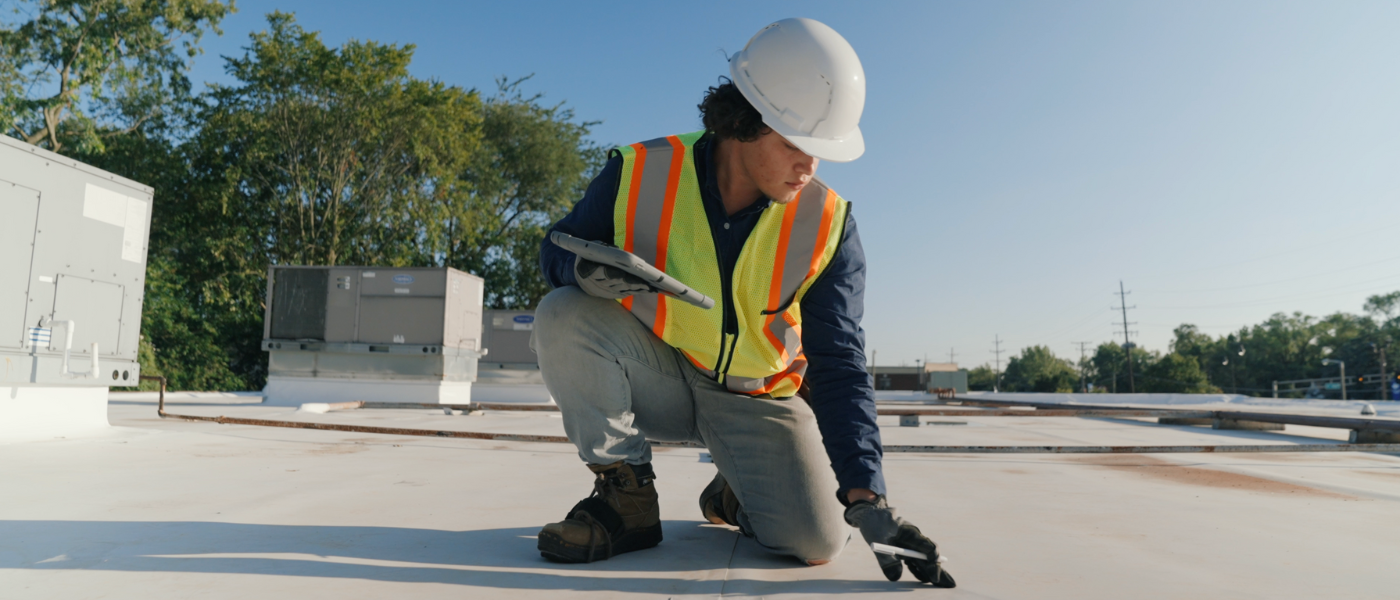
What to Expect During a Commercial Roof Inspection
Commercial roofs are designed to last between 20 and 40 years. Regular maintenance, repairs, and inspections are essential to ensure your roof lasts towards the higher end of that range.
Most commercial building owners only call roofers when there’s a problem, but regular inspections proactively identify potential issues before they become costly repairs.
For commercial building owners in the Chicagoland area, knowing what to expect during a commercial roof inspection enables you to prepare and make informed decisions regarding your property’s maintenance.
Commercial Roof Inspections are Crucial for Chicagoland Businesses
Regularly scheduled commercial roof inspections extend the lifespan of your roofing system.
Your commercial roof takes a beating in the Chicagoland area, where extreme weather patterns range from heavy snow and ice in winter to severe thunderstorms and high humidity in summer.
A single snowstorm or wind event can lead to leaks, structural damage, and interior mold growth, resulting in costly repairs and downtime. Many of these issues aren’t even visible to the untrained eye.
One of the biggest benefits of regularly scheduled commercial roof inspections is that they can address small issues early, such as minor membrane cracks, clogged drainage systems, or worn flashing, preventing them from turning into extensive (and expensive) repairs.
If you haven’t had your commercial roof inspected this year, schedule an appointment with Ridgeworth Roofing today to keep your buildings safe and protected from whatever Chicago’s weather throws at them next.
What to Expect During a Commercial Roof Inspection
Before anything else, we recommend scheduling commercial roof inspections at least twice a year, once in the spring and once in the fall.
This way, we can assess any damage from harsh weather conditions.
Consider scheduling a commercial roof inspection after significant weather events. Freeze-thaw cycles and ponding water damage roofs in our area, so it’s never a bad idea to contact a trusted roofing contractor to check everything out.
To prepare for the inspection, gather any existing documentation about your roof, including previous inspection reports, repair records, and warranty information, to provide the inspector with a comprehensive history.
Interior Inspection

The inspection process often begins inside the building.
Here, the inspector looks for signs of water intrusion, such as stains on ceilings and walls, mold growth, or unusual odors.
These indicators help pinpoint areas where the roof may be compromised.
In Chicagoland’s humid continental climate, interior signs of moisture are particularly concerning, as they can lead to mold issues if not addressed promptly.
Exterior Inspection

Next, your commercial roofing inspector examines the building’s exterior, focusing on the envelope—the barrier separating the interior from the exterior environment.
This includes checking walls, windows, doors, and other structural components for cracks, deterioration, or signs of water penetration.
Given Chicagoland’s freeze-thaw cycles, it’s crucial to identify and repair any vulnerabilities that could allow water.
Roof Surface Assessment

Once the interior and exterior of the building are completed, the inspector evaluates the surface of your commercial roof.
They are looking for common issues such as ponding water, membrane integrity, flashing and penetrations, and debris and vegetation.
In the Chicago area, where heavy snowfall and ice dams are common, special attention is given to ensuring drainage systems are clear and functional to prevent water buildup.
Drainage System Evaluation

Drainage is vital to the longevity of a commercial roof.
The inspector assesses gutters, downspouts, and internal drains and cleans them to be free from blockages and functioning correctly. Leaves and debris quickly accumulate in these areas, leaving excess water and leaky ceilings on your commercial roof.
Documentation and Reporting
After the inspection, the roofing professional provides a detailed report outlining their findings. This report typically includes:
- Current Condition
- Identified Issues
- Photographic Evidence
- Recommendations
Maintaining thorough records of each inspection helps track the roof’s condition over time and plan future maintenance budgets. These records also help with the next step in the inspection process: designing a maintenance plan.
Designing a Maintenance Plan
After the report, the inspector and your roofing contractor will create a maintenance plan for your commercial roof. This plan will include immediate repairs and other preventative measures to help prolong the roof’s lifespan.
Because every roof is different, every maintenance plan is unique to your building and the elements you may encounter.
While a roof inspection is beneficial, following up with regularly scheduled maintenance allows your commercial roof to last closer to 40 years.
Ready to Schedule a Commercial Roof Inspection? Contact Ridgeworth Roofing Today.
Haven’t had your roof inspected lately? Dealing with the effects of the latest storm? For over 50 years, our team has worked with Chicagoland businesses to install, maintain, and repair their commercial roofs.
Contact Ridgeworth Roofing today to schedule a commercial roof inspection.
